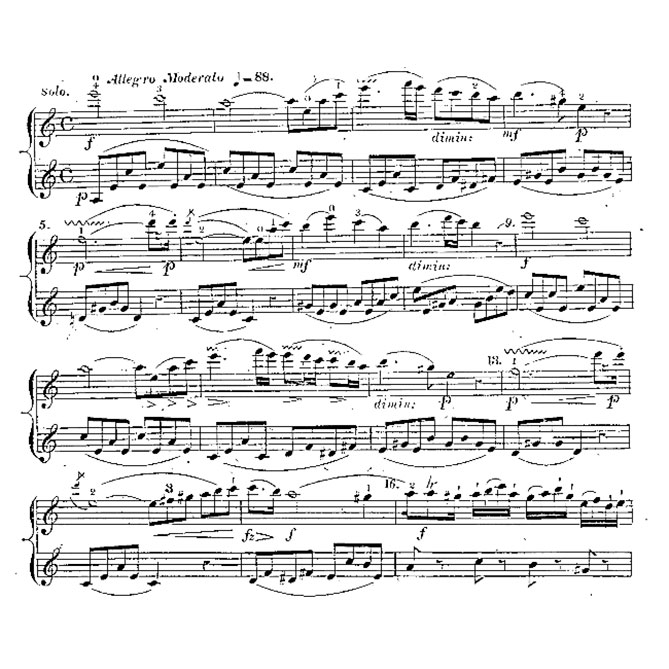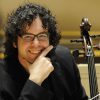
On How to Play the Baroque Cello: Vibrato (Part 2)
Guy Fishman
In last week’s post, I attempted to set out the basic arguments made by those musicians who, for over four centuries, advocated a judicious approach to the application of vibrato to stringed instrument sound, and those who, for the last ninety years or so, have championed a more continuous presence for this expressive tool. Members of the former group adhered to the original attribution of vibrato as an ornament that is most highly effective when employed sparingly, where those who belong to the latter group see it as an indispensable component of good tone production.
Two things should be kept in mind. The first is that each statement constitutes what is largely a philosophical stance, although the latter is supported by the overwhelming majority of live and recorded playing on standard instruments today. It is unknowable what aural results were achieved by the various means of vibrating on stringed instruments during the centuries prior to the recorded age. Whether a great violinist like Louis Spohr used finger vibrato, arm vibrato, bow vibrato, or other means to purposefully, regularly, and controllably alter his pitch for expressive aims is difficult to tell. What is plain to see, however, is that he wholeheartedly agreed with his predecessors and scions in their assessment of the proper role of vibrato in music-making. Not only did he write as much, but he also provided those who read his treatise on violin playing (there were many) with annotated examples, such as the one at the top of this post, in which he indicated precisely on which notes of a work he thought one should vibrate. Spohr chose the mordent symbol to designate vibrato. Surely he felt that just as no one would place an actual mordent on every note of a piece, so would no one proceed to vibrate every note. Regardless of whether or not his followers vibrated in the exact places he ascribed, they undoubtedly understood that the exercise here was in creating heightened expressivity through a variety in tone production. The use of vibrato was one factor in this, and not the dominant one. That role was played by the bow, called the “soul” of the violin not only by Spohr, but by players during the two centuries before him and in the one that followed, until around the time when Carl Flesch either instigated or reflected the trend of delegating matters of the soul to the left hand.
Performers who played during Flesch’s lifetime evinced contrary practices where vibrato was concerned, that is, if one is willing to extrapolate a “practice” from their recorded examples. It seems that violinists such as Joachim, Marie Hall, and even Sarasate were happy to limit their vibrato in recordings they made in the early 20th century. This must not have been an easy choice to make: The flutist Marcel Moyse, who was unwavering in his profound dislike of vibrato and expressed as much in his teaching throughout his life, nevertheless produced recordings where vibrato is audible and is used to mitigate the limited quality of early recording equipment. The three abovementioned violinists must not have felt the need to alter their playing to suit the studio, and their recorded sound contains both vibrated and straight tones in playing that is decidedly “romantic.”
Still, Fritz Kreisler made his first recording in 1904, in which an audible, consistent vibrato is plainly evident. Kreisler’s force of personality was such that he is credited by some being solely responsible for the shift from Joachim’s standard of tone production to that which Flesch described. A recording from 1914 by Eugène Ysaÿe displays a middle-ground practice of sorts, where vibrato is used but not prominently. These are possibly the two philosophical stances demonstrated in practice, but also show that the practice did not always reflect the vehement delivery found in written and spoken discourse on the subject.
The second thing to remember is that neither Spohr nor anyone else who commented on the “correct” application of vibrato would have bothered admonishing his readers to avoid overusing it if he had not heard a good number of doubtlessly very capable musicians doing just that. The argument that “they” did not vibrate back then, in the pre-baroque, baroque, or classical eras, is sorely mistaken. Many of “them” did vibrate in what may have been a continuous manner. Clearly “they” were not burnt at the stake or suffer the guillotine; far from it, they were likely heard by the greats of their time because they were employed in one way or another. But they did suffer the ire of the occupants of the upper stratums of just about every generation of musicians for four centuries, with remarkably few exceptions. This is made all the more notable when considering that until the middle of the twentieth century, national schools of playing existed that were delineated each from the other by clearly-defined and often contradictory traditions and preferences. Yet, despite their differences, German, Franco-Belgian, and English masters seem to have aligned where their approach to vibrato was concerned, at least until the end of the 19th century. This group of brilliant musicians counts the theorists Agricola and Gannassi, player-composers Tartini and Leopold Mozart, Spohr, Baillot, Dotzauer, and Romberg, and finally Joachim and Auer, among others, as their most prominent members. Their playing, teaching, and writing shaped the tastes of the times during which they lived. It behooves us to place much more emphasis on their example than that of the largely anonymous group of players who so profoundly irritated them, thereby inspiring their various sermons on the dangers of continuous vibrato.
In attempting to form a piece of advice on how to approach vibrato for those interested in “how to play a baroque cello,” I am struck by how far-removed I have become from the sixteen-year-old I was when I walked into that Tower Records. Soon thereafter, I became convinced of what seemed like the black-and-white world of the Early Music Movement, and gladly accepted that there were few correct ways of making music in the pre-classical period. In other words, I found purpose in adopting a narrow set of possibilities. Through research and experience I now believe demonstration of varying tastes, preferences, levels of ability, and musical adroitness—variety that is a mark of most human endeavor—must have been even more dramatically diverse before the recorded era. These clearly included what was widely considered to be a sophomoric approach to vibrato, in which its application was more or less thoughtless and automatic, and a more refined, sophisticated approach whose trademarks included an extremely agile bow arm and a varied approach to vibrato, always an ornament, never a mainstay. I look back on these time periods in order to study what composers may have been familiar with and relating the fruits of my study to the performance of their music. What is left is simply choice, and, really, a much wider set of possibilities than I had thought available in my youth.
It should not be lost on us that we are fortunate to have our choices be guided by some of the brightest minds in musical history. In practical terms, where they guide us may include some of the following: The “straight” tone should be the predominant expedient of a composition from the sixteenth through the end of the nineteenth centuries. The bow is our most expressive tool, and it should be tasked with the majority of the coloring and shaping of the work at hand. Audible vibrato of any sort should be applied after careful consideration as to its placement, width and speed, and most importantly, purpose. I say “audible” because I quite agree with David Soyer in that the hand should remain spry, and that some motion of the hand while balanced on the playing finger is desirable for fostering facility and relaxation. But a relaxed hand and a tone that is more or less straight and owes its beauty more to the bow and less to vibrato are not necessarily mutually exclusive.
I have used the word “role” several times over this and my last post. Ultimately, the role of vibrato, and, indeed, your role in whatever setting you are playing in are the final arbiters of what kind and amount of vibrato you should use. For instance, when playing a harmonic role in a chamber ensemble, why not consider lessening the amount of vibrato you use so that the melodic lines are more clearly heard, and presumably with more vibrato? When playing in a large ensemble or orchestra, do repeated eighth notes in symphony by Haydn, whose purpose is to provide a harmonic foundation and rhythmic drive, require constant vibrato, as a conductor has recently asked of a section I was playing in? (Interesting results, well-worth considering, have been achieved by Roger Norrington and Thomas Dausgaard with standard-instrument orchestras playing late 19th-century, whose string players use steel strings, but who heavily restrict the use of vibrato and, furthermore, use it at the same places throughout the section. Especially noteworthy is the playing with vibrato when juxtaposed with non-vibrato).
When accompanying a non-vibrating instrument such as the piano (especially an early one), even in a sonata for your instrument, what use is a sound supposedly made beautiful by continuous vibrato if it obscures your colleague’s more meaningful role? It is during such moments in particular when I am reminded of a lesson I learned when Laurence Lesser compared my use of vibrato to that of perfume in the hands of 18th century aristocrats. Their habit of bathing infrequently necessitated heavy doses of perfume. Likewise, the lackluster and unfocused use of my bow required a heavy application of vibrato to my sound. I was covering up a pungent sound with fragrant perfume. Produce a great sound with your bow, and you won’t need much vibrato. The vibrato you choose to use then will be doubly expressive.
As for expressivity, I am reminded of a sad event every parent experiences, that of hearing my child cry in pain. My daughter fell off her bike and scraped her nose. The sound she produced when crying for me was neither well-supported nor vibrated, but it was expressive in the extreme. There is nothing intrinsically expressive about vibrato, nor inexpressive about straight tone. The decisive consideration is the music, and what you believe the intention of the composer was. The avoidance of dogma—“never vibrate” or “never cease vibrating”—should be one of the central pursuits of arriving at such considerations. Using vibrato is but one way to draw attention to moments in the music you feel are important; you have as many ways of doing so as your imagination and technique allow for. Use vibrato as a matter of course, and everything becomes equally important and unimportant at the same time. The beauty of the device is tarnished by its overuse, and the music suffers from a supposed expressivity so heightened as to become monotonous. Finally, this is what the aforementioned writers tell us: limit the use of each of your expressive tools, and you will immeasurably increase its power to move.
Subjects: Baroque, Historical
Tags: arm vibrato, Baroque, bow, bow vibrato, cellobello, CelloBlog, finger vibrato, Flesch, Guy Fishman, Haydn, vibrato
